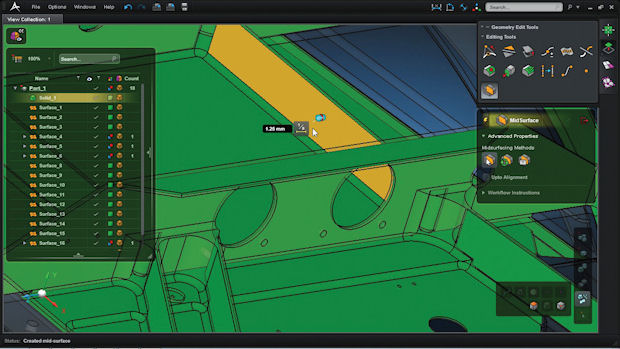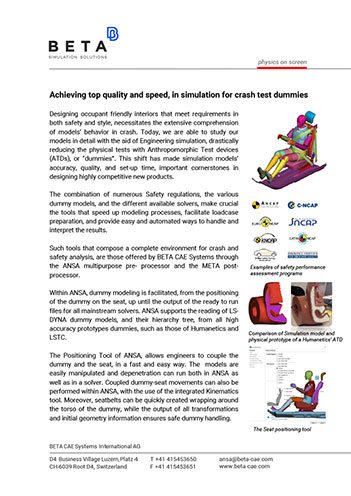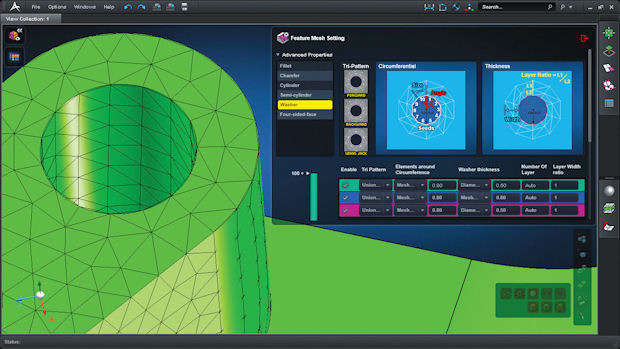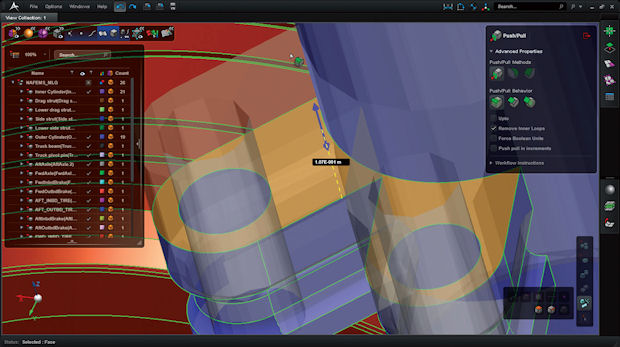MSC Rethinks CAE Software with Apex

With MSC Apex Modeler software, users can extract mid-surfaces from an imported CAD solid to prepare models for FE analysis. Images courtesy of MSC Software.
Pre-processing and Meshing News
Pre-processing and Meshing Resources

Latest News
December 1, 2014
 With MSC Apex Modeler software, users can extract mid-surfaces from an imported CAD solid to prepare models for FE analysis. Images courtesy of MSC Software.
With MSC Apex Modeler software, users can extract mid-surfaces from an imported CAD solid to prepare models for FE analysis. Images courtesy of MSC Software.In the world of mechanical analysis, the power of finite element analysis (FEA) software is extraordinary. However, the process of applying it has often been slow and linear. Create a CAD model, define materials, loads and boundary conditions, mesh the geometry, run the correct solver-type, troubleshoot any model errors that prevent successful analysis, study the results, modify the design geometry; repeat.
MSC Software has both compressed and expanded these steps with a new approach that helps users perform rapid “what-if” studies early to speed up conceptual designs. Its new MSC Apex family of software products, starting with MSC Apex Modeler and MSC Apex Structures, rearranges the traditional CAE process by simplifying model preparation, then combining what it calls computational parts and computational assemblies into mechanical systems that are quick to edit, share and rerun.
The company is responding to common complaints of design engineers trying to apply simulation in their workflow: the software is too hard to learn and use; cleaning up geometry and meshing takes too much time; moving models or results among designers, engineers and analysts is inefficient; simulation models are hardly ever useful to the full supply chain, and more.
“With the MSC Apex Platform we created an environment with a unique user experience, that is easy-to-use, and easy-to-learn,” says Hugues Jeancolas, MSC Software Apex product manager. “This ease-of-use is partly enabled by its unique CAE Specific Direct Modeling capability, and integrated solver methods.”
Focusing on Ease and Speed
Simplifying the full CAD-to-mesh process is one of the goals of the MSC Apex system. From the very first step, users see a new look and feel for an analysis preparation user-interface. MSC Apex Modeler, launched in October, directly imports most standard CAD geometry file-types then operates with grab/move/release direct modeling for easy design geometry edits and repair. No pull-down menus or “OK” buttons are involved, relevant function icons are easily accessible from the surrounding frame, and a full-screen mode allows uncluttered views. Just as important, the software supports fast de-featuring, recognition of chamfers and fillets, automatic extraction of mid-surfaces and multi-thickness surface model creation, all without going back to the original CAD package.
 In MSC Apex Modeler, finite element mesh definitions can be set based on feature type and dimension.
In MSC Apex Modeler, finite element mesh definitions can be set based on feature type and dimension.The MSC Apex system also saves time by validating each part prior to its use in an assembly then meshing the full assembly only once. When users make changes to the CAD geometry, the system automatically re-meshes just the portions of the geometry that changed, and displays the new mesh in real-time. The functions are so intuitive, Jeancolas says users can get up and running in just four hours. More than 100 how-to videos are embedded and directly accessible as each tool is employed.
Ian Draycott, engineering stress lead at TLG Aerospace, a Seattle-based aerospace engineering services company, has been using MSC software for years and MSC Apex Modeler since July. “Apex takes what used to be time consuming and frustrating geometry tasks using traditional solid modeling programs and turns them instead into efficient and satisfying tasks,” he says. “The ability to create mid-planes on the fly and to quickly simplify geometry for meshing purposes is unmatched.
“With the dynamic meshing process, the results of changes to geometry and mesh parameters are immediately apparent. This allows the user to achieve a high quality mesh in significantly less time when compared to traditional meshing applications,” Draycott says.
Rethinking Solver Technology
Users can feed the models into a traditional Patran/MSC Nastran analysis path, and MSC says Apex Modeler is already speeding up pre-processing for such analyses by factors of two to 10. However, the full benefits of the MSC Apex CAE system will be seen when users transfer meshed MSC Apex Modeler files into the add-on product MSC Apex Structures. This analysis solution, soon to be released in beta form, performs incremental validations of each part, which then feed into the FE analysis of a complete assembly. The software uses the concept of computational parts (CPs) as an equivalent for each component: It represents the effective part behavior based on user-defined boundary conditions, loads and materials.
Each CP is a mathematical model that defines the behavior independently from other parts in an assembly. A CP has a boundary called a communicator region, where the part can be connected to other parts. The initial release supports glue connections. Each CP is characterized by appropriate local boundary conditions as well as sensors defined by the key metrics that users want to capture. CPs can be either reduced via static or dynamic reduction, or not reduced for a full fidelity model.
Instead of reassembling and resolving an assembly the traditional way, the MSC Apex Structures solver first pre-computes part-behavior for each part in an assembly. With this new approach, when a change is made to a part, whether it is a material, boundary condition, or mesh change, the software immediately accesses the previously defined operating parameters and analyzes the modified regions, not the entire assembly. The combination of incremental validation and incremental solutions produces iterative results up to 10 times faster than without the use of CPs.
A CAE Modeling and Workflow Transformation
Designed to be highly interactive and appropriate for rapid design-envelope exploration analyses, MSC Apex will not replace MSC Nastran but will augment its capabilities. Final design validation and verification analyses are expected to remain in MSC Nastran. The MSC Apex platform will be extended to complement other MSC products, supporting multi-user, multi-discipline and multi-fidelity functions.
MSC Apex Modeler is currently for sale; the beta release of MSC Apex Structures (with CP-based linear structural and modal analysis capabilities) is planned to be available this year.
More Info
Subscribe to our FREE magazine, FREE email newsletters or both!
Latest News
About the Author
Pamela Waterman worked as Digital Engineering’s contributing editor for two decades. Contact her via .(JavaScript must be enabled to view this email address).
Follow DE




